Health Care Study of Hospiscare
VerifiedAdded on 2022/08/14
|9
|1711
|17
AI Summary
Contribute Materials
Your contribution can guide someone’s learning journey. Share your
documents today.
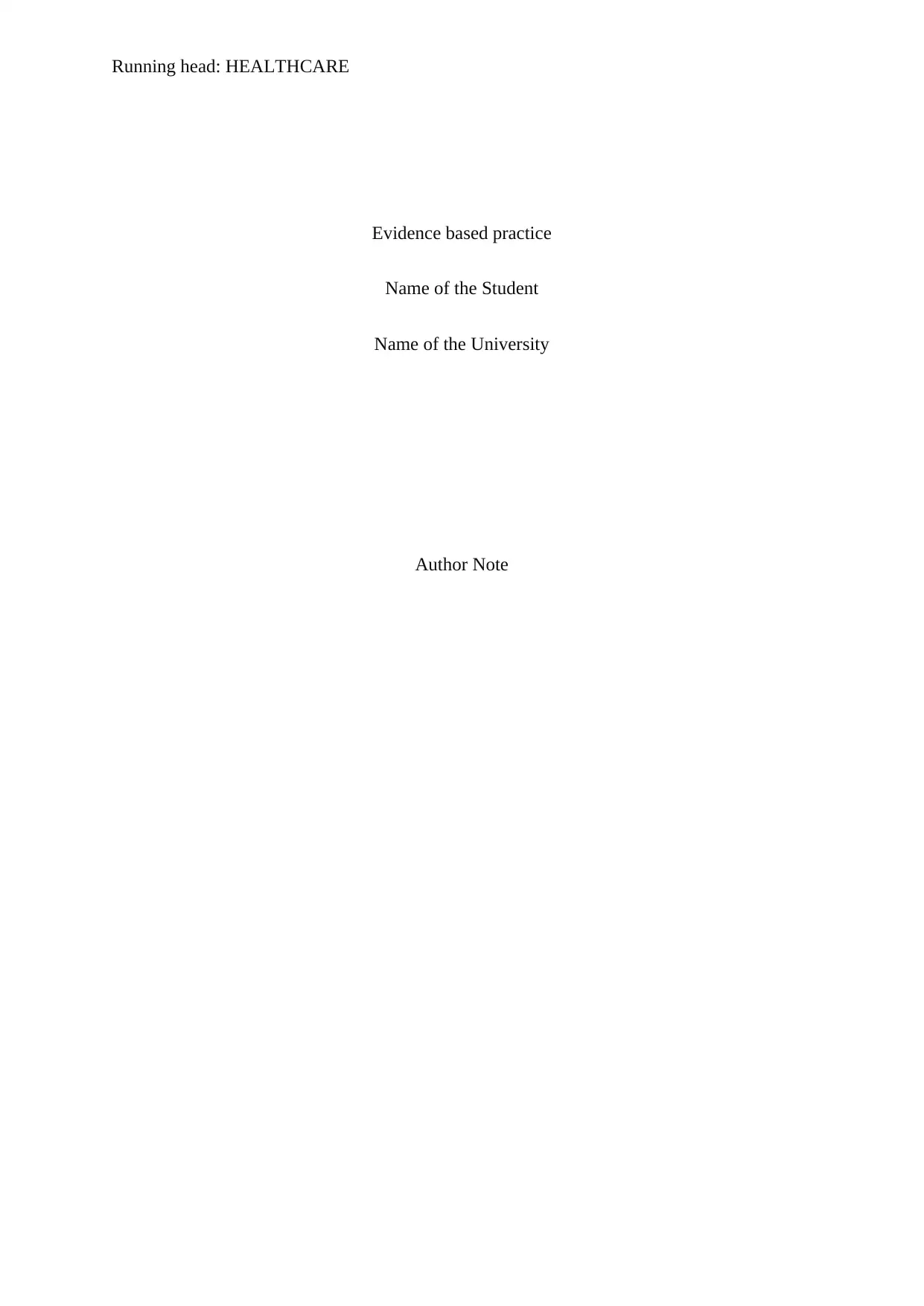
Running head: HEALTHCARE
Evidence based practice
Name of the Student
Name of the University
Author Note
Evidence based practice
Name of the Student
Name of the University
Author Note
Secure Best Marks with AI Grader
Need help grading? Try our AI Grader for instant feedback on your assignments.
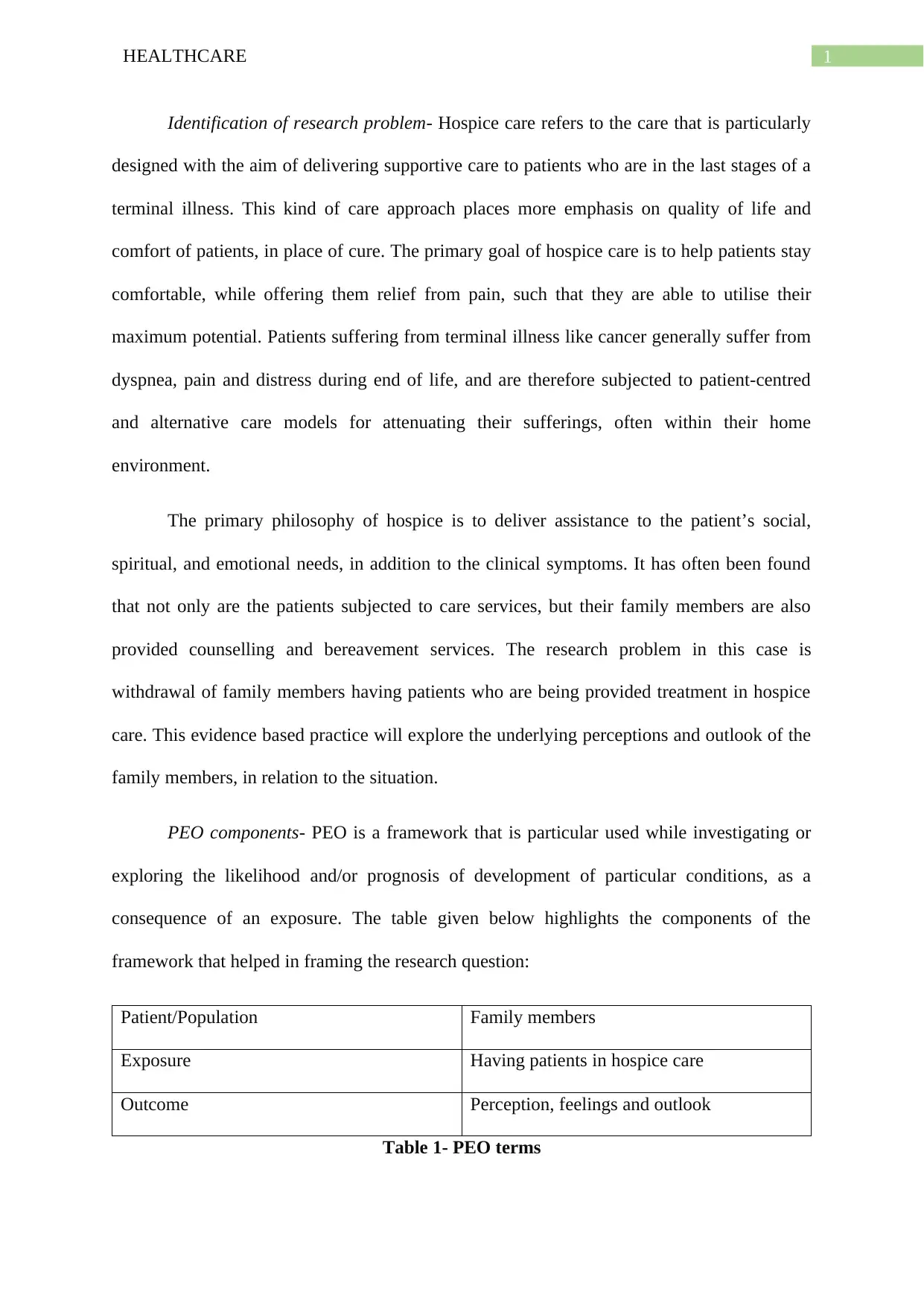
1HEALTHCARE
Identification of research problem- Hospice care refers to the care that is particularly
designed with the aim of delivering supportive care to patients who are in the last stages of a
terminal illness. This kind of care approach places more emphasis on quality of life and
comfort of patients, in place of cure. The primary goal of hospice care is to help patients stay
comfortable, while offering them relief from pain, such that they are able to utilise their
maximum potential. Patients suffering from terminal illness like cancer generally suffer from
dyspnea, pain and distress during end of life, and are therefore subjected to patient-centred
and alternative care models for attenuating their sufferings, often within their home
environment.
The primary philosophy of hospice is to deliver assistance to the patient’s social,
spiritual, and emotional needs, in addition to the clinical symptoms. It has often been found
that not only are the patients subjected to care services, but their family members are also
provided counselling and bereavement services. The research problem in this case is
withdrawal of family members having patients who are being provided treatment in hospice
care. This evidence based practice will explore the underlying perceptions and outlook of the
family members, in relation to the situation.
PEO components- PEO is a framework that is particular used while investigating or
exploring the likelihood and/or prognosis of development of particular conditions, as a
consequence of an exposure. The table given below highlights the components of the
framework that helped in framing the research question:
Patient/Population Family members
Exposure Having patients in hospice care
Outcome Perception, feelings and outlook
Table 1- PEO terms
Identification of research problem- Hospice care refers to the care that is particularly
designed with the aim of delivering supportive care to patients who are in the last stages of a
terminal illness. This kind of care approach places more emphasis on quality of life and
comfort of patients, in place of cure. The primary goal of hospice care is to help patients stay
comfortable, while offering them relief from pain, such that they are able to utilise their
maximum potential. Patients suffering from terminal illness like cancer generally suffer from
dyspnea, pain and distress during end of life, and are therefore subjected to patient-centred
and alternative care models for attenuating their sufferings, often within their home
environment.
The primary philosophy of hospice is to deliver assistance to the patient’s social,
spiritual, and emotional needs, in addition to the clinical symptoms. It has often been found
that not only are the patients subjected to care services, but their family members are also
provided counselling and bereavement services. The research problem in this case is
withdrawal of family members having patients who are being provided treatment in hospice
care. This evidence based practice will explore the underlying perceptions and outlook of the
family members, in relation to the situation.
PEO components- PEO is a framework that is particular used while investigating or
exploring the likelihood and/or prognosis of development of particular conditions, as a
consequence of an exposure. The table given below highlights the components of the
framework that helped in framing the research question:
Patient/Population Family members
Exposure Having patients in hospice care
Outcome Perception, feelings and outlook
Table 1- PEO terms
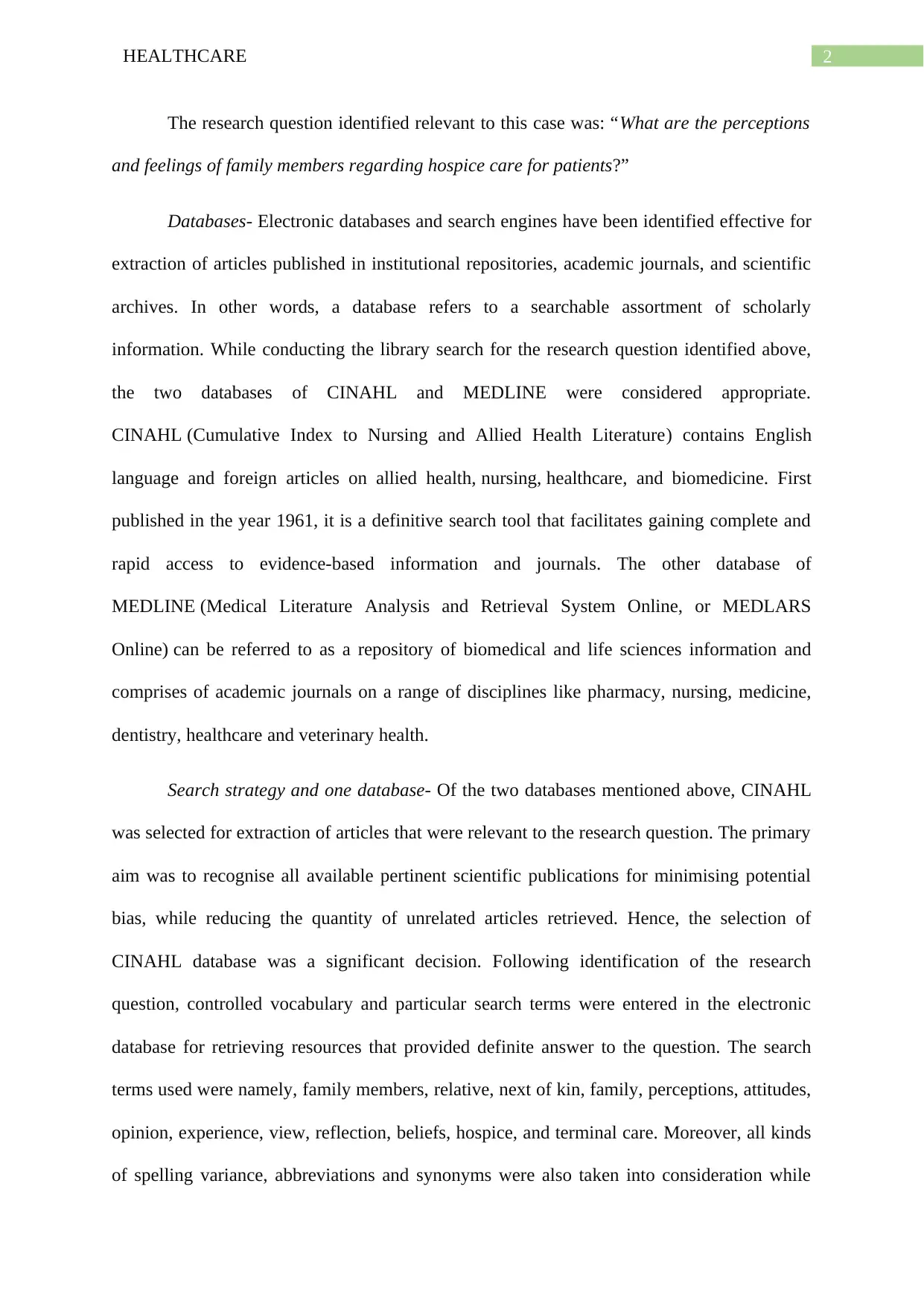
2HEALTHCARE
The research question identified relevant to this case was: “What are the perceptions
and feelings of family members regarding hospice care for patients?”
Databases- Electronic databases and search engines have been identified effective for
extraction of articles published in institutional repositories, academic journals, and scientific
archives. In other words, a database refers to a searchable assortment of scholarly
information. While conducting the library search for the research question identified above,
the two databases of CINAHL and MEDLINE were considered appropriate.
CINAHL (Cumulative Index to Nursing and Allied Health Literature) contains English
language and foreign articles on allied health, nursing, healthcare, and biomedicine. First
published in the year 1961, it is a definitive search tool that facilitates gaining complete and
rapid access to evidence-based information and journals. The other database of
MEDLINE (Medical Literature Analysis and Retrieval System Online, or MEDLARS
Online) can be referred to as a repository of biomedical and life sciences information and
comprises of academic journals on a range of disciplines like pharmacy, nursing, medicine,
dentistry, healthcare and veterinary health.
Search strategy and one database- Of the two databases mentioned above, CINAHL
was selected for extraction of articles that were relevant to the research question. The primary
aim was to recognise all available pertinent scientific publications for minimising potential
bias, while reducing the quantity of unrelated articles retrieved. Hence, the selection of
CINAHL database was a significant decision. Following identification of the research
question, controlled vocabulary and particular search terms were entered in the electronic
database for retrieving resources that provided definite answer to the question. The search
terms used were namely, family members, relative, next of kin, family, perceptions, attitudes,
opinion, experience, view, reflection, beliefs, hospice, and terminal care. Moreover, all kinds
of spelling variance, abbreviations and synonyms were also taken into consideration while
The research question identified relevant to this case was: “What are the perceptions
and feelings of family members regarding hospice care for patients?”
Databases- Electronic databases and search engines have been identified effective for
extraction of articles published in institutional repositories, academic journals, and scientific
archives. In other words, a database refers to a searchable assortment of scholarly
information. While conducting the library search for the research question identified above,
the two databases of CINAHL and MEDLINE were considered appropriate.
CINAHL (Cumulative Index to Nursing and Allied Health Literature) contains English
language and foreign articles on allied health, nursing, healthcare, and biomedicine. First
published in the year 1961, it is a definitive search tool that facilitates gaining complete and
rapid access to evidence-based information and journals. The other database of
MEDLINE (Medical Literature Analysis and Retrieval System Online, or MEDLARS
Online) can be referred to as a repository of biomedical and life sciences information and
comprises of academic journals on a range of disciplines like pharmacy, nursing, medicine,
dentistry, healthcare and veterinary health.
Search strategy and one database- Of the two databases mentioned above, CINAHL
was selected for extraction of articles that were relevant to the research question. The primary
aim was to recognise all available pertinent scientific publications for minimising potential
bias, while reducing the quantity of unrelated articles retrieved. Hence, the selection of
CINAHL database was a significant decision. Following identification of the research
question, controlled vocabulary and particular search terms were entered in the electronic
database for retrieving resources that provided definite answer to the question. The search
terms used were namely, family members, relative, next of kin, family, perceptions, attitudes,
opinion, experience, view, reflection, beliefs, hospice, and terminal care. Moreover, all kinds
of spelling variance, abbreviations and synonyms were also taken into consideration while
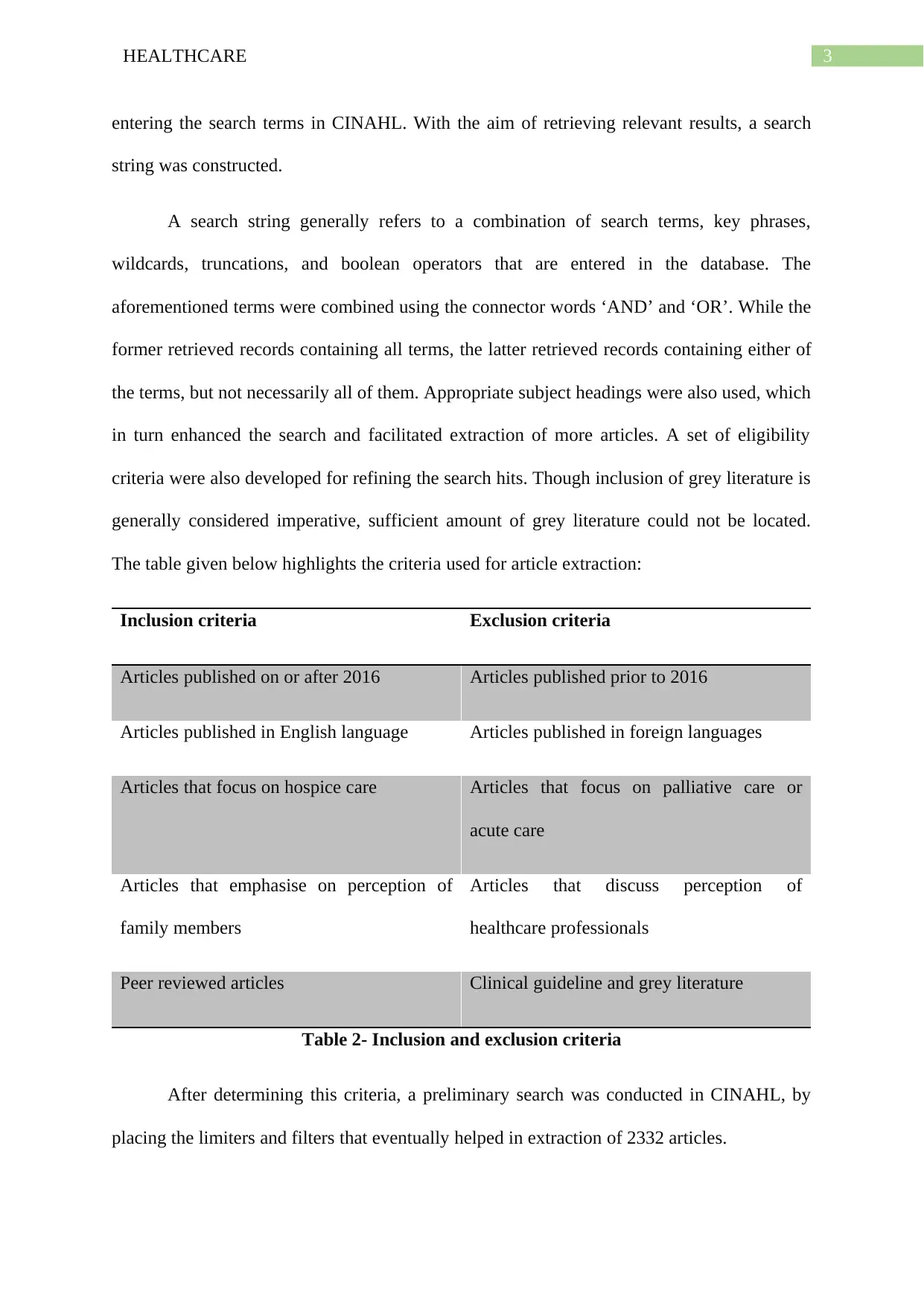
3HEALTHCARE
entering the search terms in CINAHL. With the aim of retrieving relevant results, a search
string was constructed.
A search string generally refers to a combination of search terms, key phrases,
wildcards, truncations, and boolean operators that are entered in the database. The
aforementioned terms were combined using the connector words ‘AND’ and ‘OR’. While the
former retrieved records containing all terms, the latter retrieved records containing either of
the terms, but not necessarily all of them. Appropriate subject headings were also used, which
in turn enhanced the search and facilitated extraction of more articles. A set of eligibility
criteria were also developed for refining the search hits. Though inclusion of grey literature is
generally considered imperative, sufficient amount of grey literature could not be located.
The table given below highlights the criteria used for article extraction:
Inclusion criteria Exclusion criteria
Articles published on or after 2016 Articles published prior to 2016
Articles published in English language Articles published in foreign languages
Articles that focus on hospice care Articles that focus on palliative care or
acute care
Articles that emphasise on perception of
family members
Articles that discuss perception of
healthcare professionals
Peer reviewed articles Clinical guideline and grey literature
Table 2- Inclusion and exclusion criteria
After determining this criteria, a preliminary search was conducted in CINAHL, by
placing the limiters and filters that eventually helped in extraction of 2332 articles.
entering the search terms in CINAHL. With the aim of retrieving relevant results, a search
string was constructed.
A search string generally refers to a combination of search terms, key phrases,
wildcards, truncations, and boolean operators that are entered in the database. The
aforementioned terms were combined using the connector words ‘AND’ and ‘OR’. While the
former retrieved records containing all terms, the latter retrieved records containing either of
the terms, but not necessarily all of them. Appropriate subject headings were also used, which
in turn enhanced the search and facilitated extraction of more articles. A set of eligibility
criteria were also developed for refining the search hits. Though inclusion of grey literature is
generally considered imperative, sufficient amount of grey literature could not be located.
The table given below highlights the criteria used for article extraction:
Inclusion criteria Exclusion criteria
Articles published on or after 2016 Articles published prior to 2016
Articles published in English language Articles published in foreign languages
Articles that focus on hospice care Articles that focus on palliative care or
acute care
Articles that emphasise on perception of
family members
Articles that discuss perception of
healthcare professionals
Peer reviewed articles Clinical guideline and grey literature
Table 2- Inclusion and exclusion criteria
After determining this criteria, a preliminary search was conducted in CINAHL, by
placing the limiters and filters that eventually helped in extraction of 2332 articles.
Secure Best Marks with AI Grader
Need help grading? Try our AI Grader for instant feedback on your assignments.
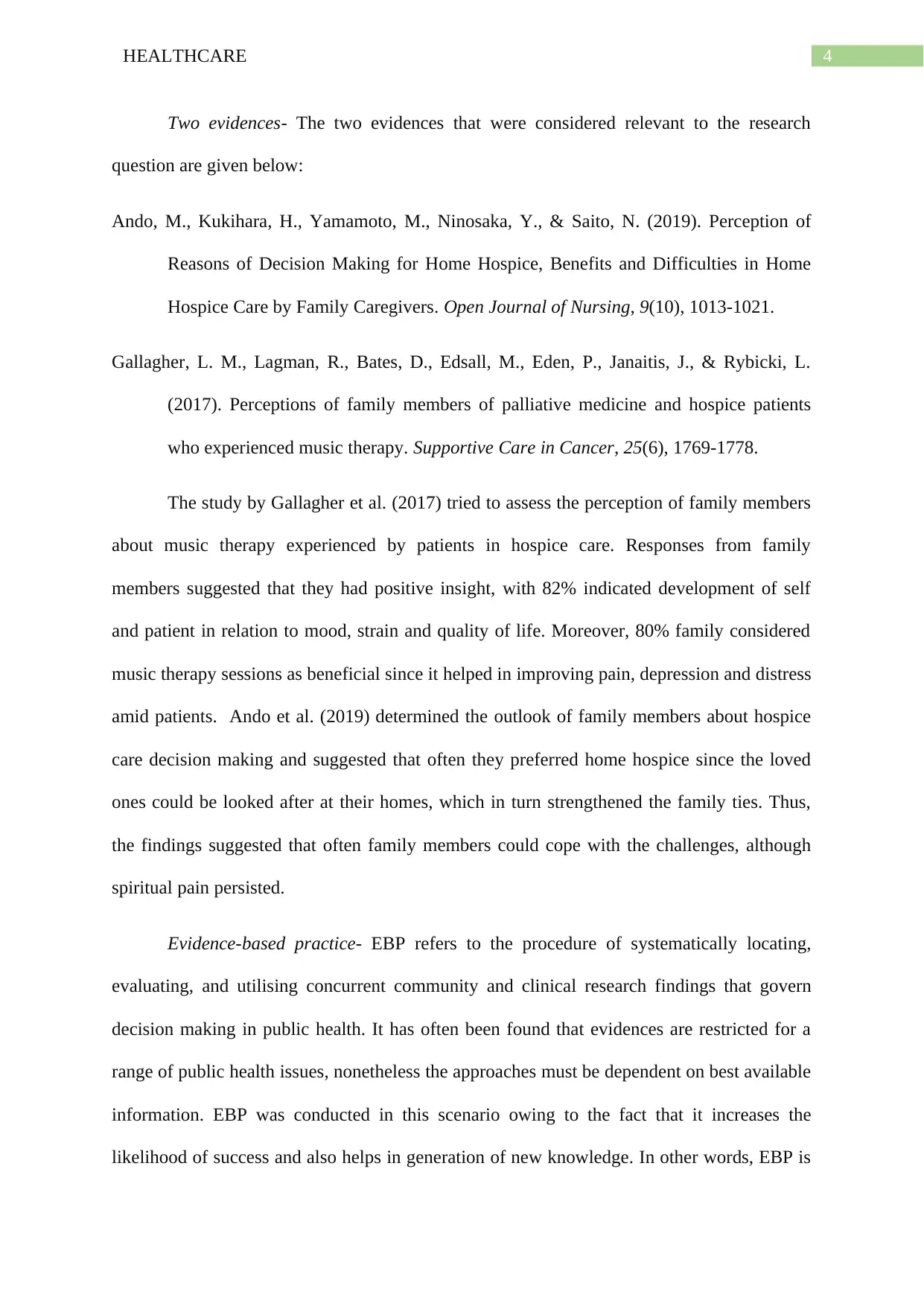
4HEALTHCARE
Two evidences- The two evidences that were considered relevant to the research
question are given below:
Ando, M., Kukihara, H., Yamamoto, M., Ninosaka, Y., & Saito, N. (2019). Perception of
Reasons of Decision Making for Home Hospice, Benefits and Difficulties in Home
Hospice Care by Family Caregivers. Open Journal of Nursing, 9(10), 1013-1021.
Gallagher, L. M., Lagman, R., Bates, D., Edsall, M., Eden, P., Janaitis, J., & Rybicki, L.
(2017). Perceptions of family members of palliative medicine and hospice patients
who experienced music therapy. Supportive Care in Cancer, 25(6), 1769-1778.
The study by Gallagher et al. (2017) tried to assess the perception of family members
about music therapy experienced by patients in hospice care. Responses from family
members suggested that they had positive insight, with 82% indicated development of self
and patient in relation to mood, strain and quality of life. Moreover, 80% family considered
music therapy sessions as beneficial since it helped in improving pain, depression and distress
amid patients. Ando et al. (2019) determined the outlook of family members about hospice
care decision making and suggested that often they preferred home hospice since the loved
ones could be looked after at their homes, which in turn strengthened the family ties. Thus,
the findings suggested that often family members could cope with the challenges, although
spiritual pain persisted.
Evidence-based practice- EBP refers to the procedure of systematically locating,
evaluating, and utilising concurrent community and clinical research findings that govern
decision making in public health. It has often been found that evidences are restricted for a
range of public health issues, nonetheless the approaches must be dependent on best available
information. EBP was conducted in this scenario owing to the fact that it increases the
likelihood of success and also helps in generation of new knowledge. In other words, EBP is
Two evidences- The two evidences that were considered relevant to the research
question are given below:
Ando, M., Kukihara, H., Yamamoto, M., Ninosaka, Y., & Saito, N. (2019). Perception of
Reasons of Decision Making for Home Hospice, Benefits and Difficulties in Home
Hospice Care by Family Caregivers. Open Journal of Nursing, 9(10), 1013-1021.
Gallagher, L. M., Lagman, R., Bates, D., Edsall, M., Eden, P., Janaitis, J., & Rybicki, L.
(2017). Perceptions of family members of palliative medicine and hospice patients
who experienced music therapy. Supportive Care in Cancer, 25(6), 1769-1778.
The study by Gallagher et al. (2017) tried to assess the perception of family members
about music therapy experienced by patients in hospice care. Responses from family
members suggested that they had positive insight, with 82% indicated development of self
and patient in relation to mood, strain and quality of life. Moreover, 80% family considered
music therapy sessions as beneficial since it helped in improving pain, depression and distress
amid patients. Ando et al. (2019) determined the outlook of family members about hospice
care decision making and suggested that often they preferred home hospice since the loved
ones could be looked after at their homes, which in turn strengthened the family ties. Thus,
the findings suggested that often family members could cope with the challenges, although
spiritual pain persisted.
Evidence-based practice- EBP refers to the procedure of systematically locating,
evaluating, and utilising concurrent community and clinical research findings that govern
decision making in public health. It has often been found that evidences are restricted for a
range of public health issues, nonetheless the approaches must be dependent on best available
information. EBP was conducted in this scenario owing to the fact that it increases the
likelihood of success and also helps in generation of new knowledge. In other words, EBP is
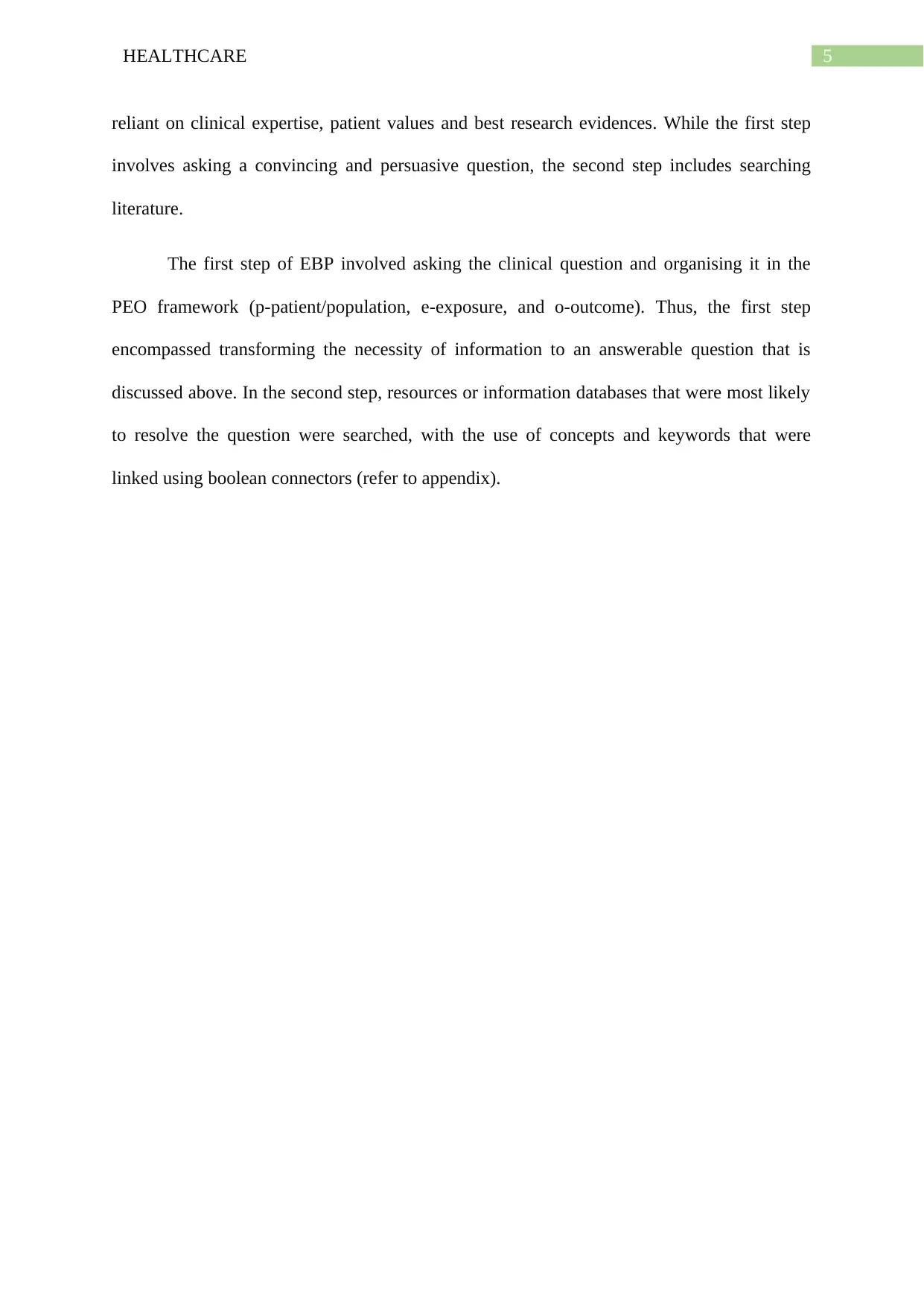
5HEALTHCARE
reliant on clinical expertise, patient values and best research evidences. While the first step
involves asking a convincing and persuasive question, the second step includes searching
literature.
The first step of EBP involved asking the clinical question and organising it in the
PEO framework (p-patient/population, e-exposure, and o-outcome). Thus, the first step
encompassed transforming the necessity of information to an answerable question that is
discussed above. In the second step, resources or information databases that were most likely
to resolve the question were searched, with the use of concepts and keywords that were
linked using boolean connectors (refer to appendix).
reliant on clinical expertise, patient values and best research evidences. While the first step
involves asking a convincing and persuasive question, the second step includes searching
literature.
The first step of EBP involved asking the clinical question and organising it in the
PEO framework (p-patient/population, e-exposure, and o-outcome). Thus, the first step
encompassed transforming the necessity of information to an answerable question that is
discussed above. In the second step, resources or information databases that were most likely
to resolve the question were searched, with the use of concepts and keywords that were
linked using boolean connectors (refer to appendix).
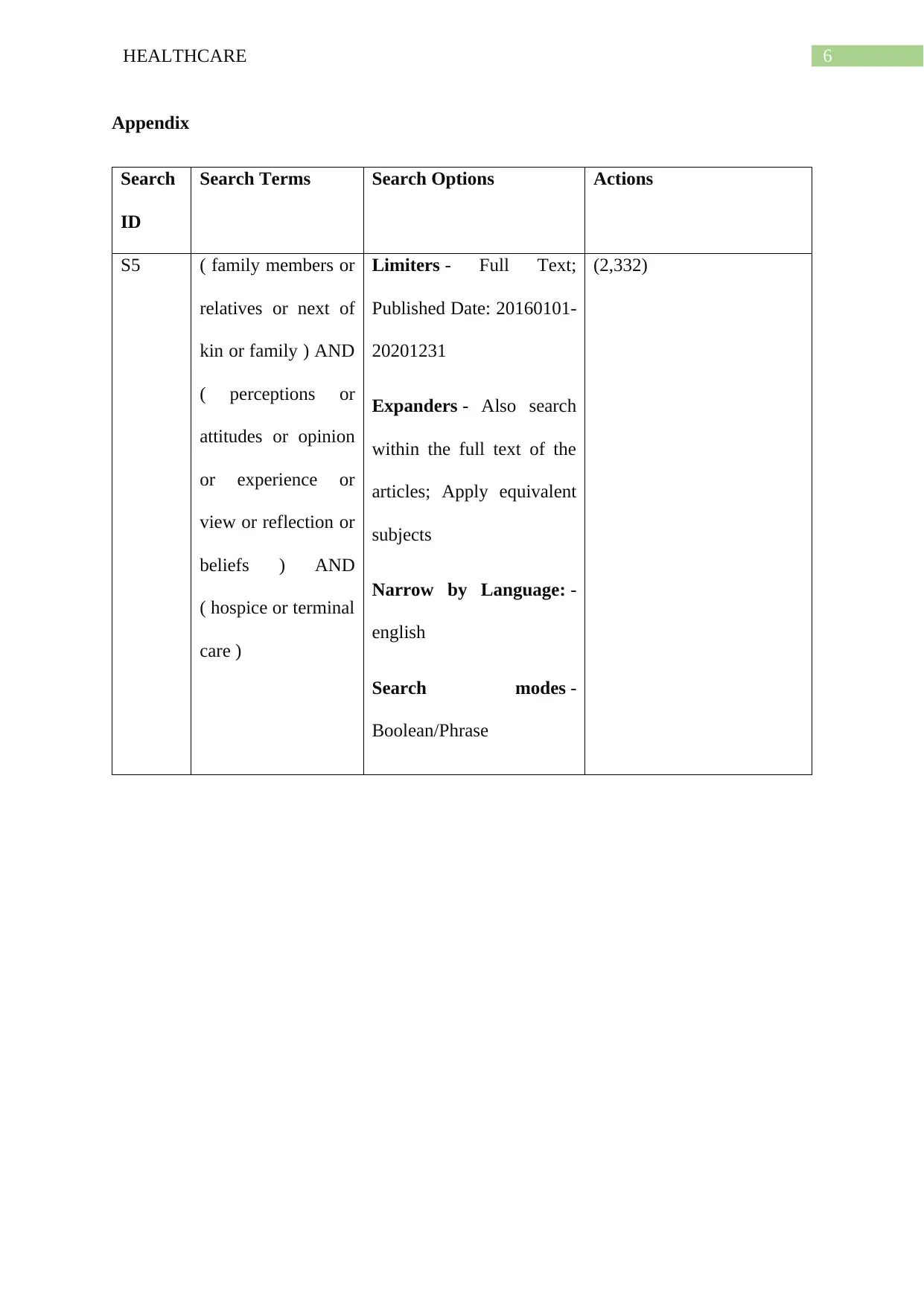
6HEALTHCARE
Appendix
Search
ID
Search Terms Search Options Actions
S5 ( family members or
relatives or next of
kin or family ) AND
( perceptions or
attitudes or opinion
or experience or
view or reflection or
beliefs ) AND
( hospice or terminal
care )
Limiters - Full Text;
Published Date: 20160101-
20201231
Expanders - Also search
within the full text of the
articles; Apply equivalent
subjects
Narrow by Language: -
english
Search modes -
Boolean/Phrase
(2,332)
Appendix
Search
ID
Search Terms Search Options Actions
S5 ( family members or
relatives or next of
kin or family ) AND
( perceptions or
attitudes or opinion
or experience or
view or reflection or
beliefs ) AND
( hospice or terminal
care )
Limiters - Full Text;
Published Date: 20160101-
20201231
Expanders - Also search
within the full text of the
articles; Apply equivalent
subjects
Narrow by Language: -
english
Search modes -
Boolean/Phrase
(2,332)
Paraphrase This Document
Need a fresh take? Get an instant paraphrase of this document with our AI Paraphraser
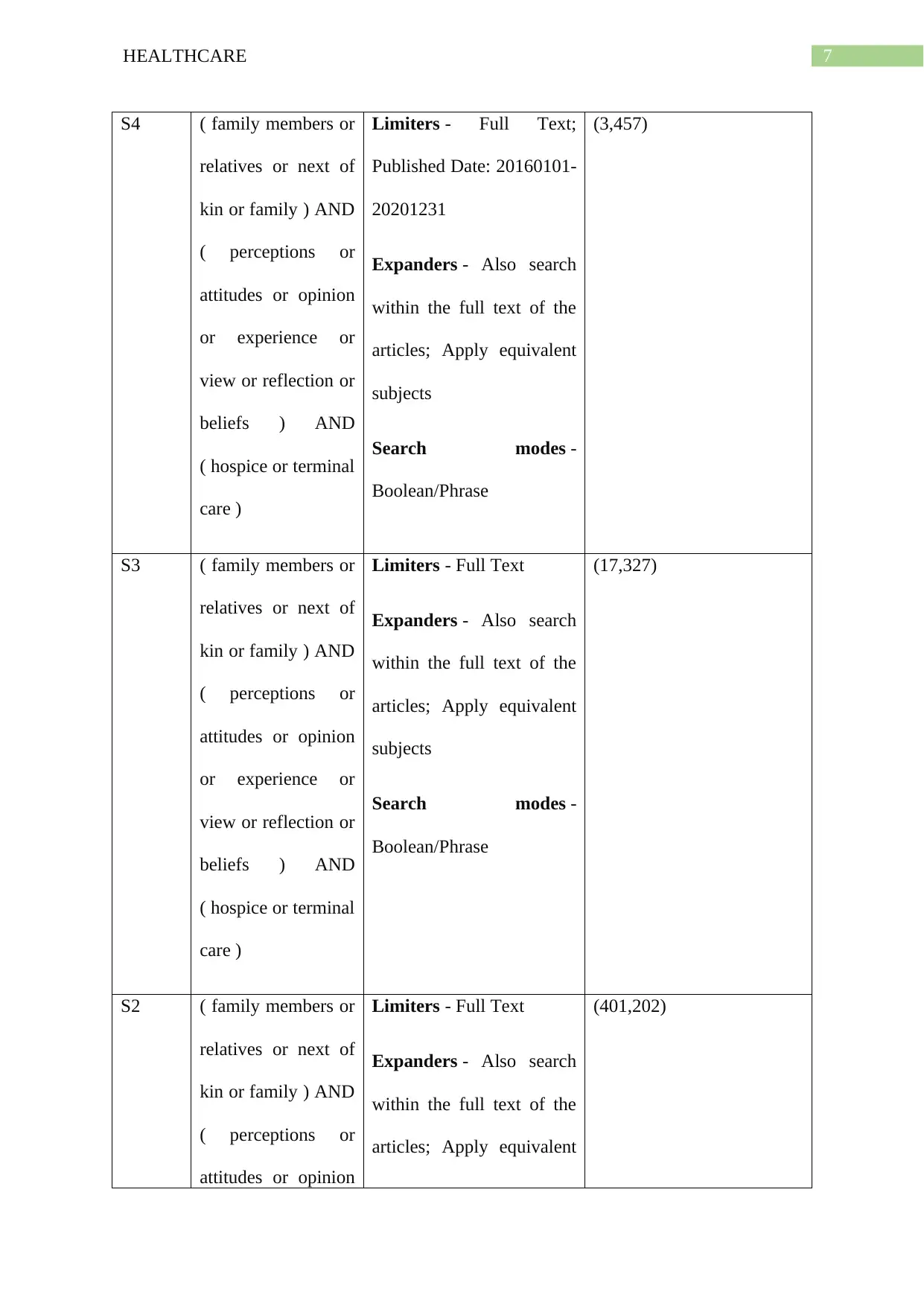
7HEALTHCARE
S4 ( family members or
relatives or next of
kin or family ) AND
( perceptions or
attitudes or opinion
or experience or
view or reflection or
beliefs ) AND
( hospice or terminal
care )
Limiters - Full Text;
Published Date: 20160101-
20201231
Expanders - Also search
within the full text of the
articles; Apply equivalent
subjects
Search modes -
Boolean/Phrase
(3,457)
S3 ( family members or
relatives or next of
kin or family ) AND
( perceptions or
attitudes or opinion
or experience or
view or reflection or
beliefs ) AND
( hospice or terminal
care )
Limiters - Full Text
Expanders - Also search
within the full text of the
articles; Apply equivalent
subjects
Search modes -
Boolean/Phrase
(17,327)
S2 ( family members or
relatives or next of
kin or family ) AND
( perceptions or
attitudes or opinion
Limiters - Full Text
Expanders - Also search
within the full text of the
articles; Apply equivalent
(401,202)
S4 ( family members or
relatives or next of
kin or family ) AND
( perceptions or
attitudes or opinion
or experience or
view or reflection or
beliefs ) AND
( hospice or terminal
care )
Limiters - Full Text;
Published Date: 20160101-
20201231
Expanders - Also search
within the full text of the
articles; Apply equivalent
subjects
Search modes -
Boolean/Phrase
(3,457)
S3 ( family members or
relatives or next of
kin or family ) AND
( perceptions or
attitudes or opinion
or experience or
view or reflection or
beliefs ) AND
( hospice or terminal
care )
Limiters - Full Text
Expanders - Also search
within the full text of the
articles; Apply equivalent
subjects
Search modes -
Boolean/Phrase
(17,327)
S2 ( family members or
relatives or next of
kin or family ) AND
( perceptions or
attitudes or opinion
Limiters - Full Text
Expanders - Also search
within the full text of the
articles; Apply equivalent
(401,202)
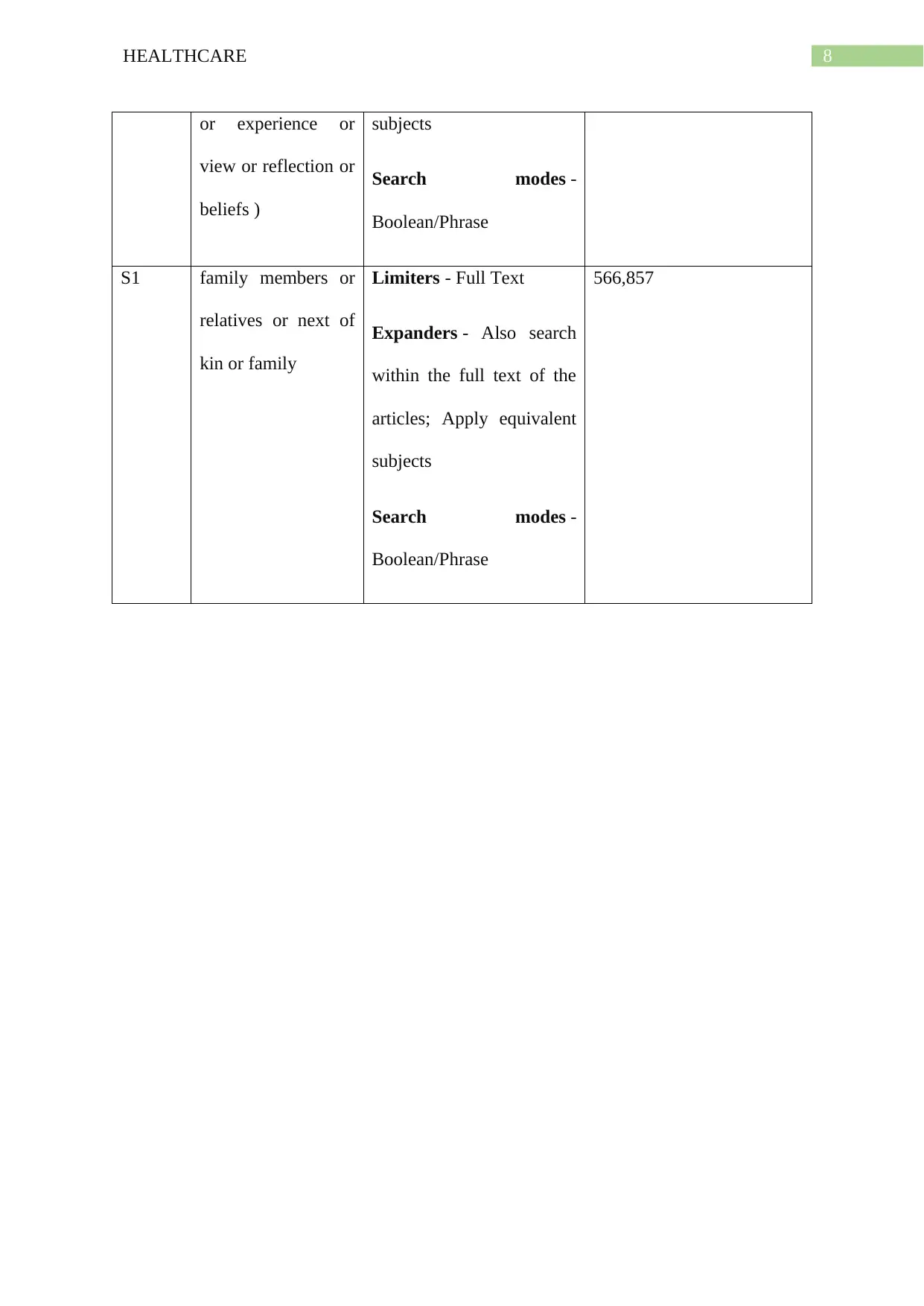
8HEALTHCARE
or experience or
view or reflection or
beliefs )
subjects
Search modes -
Boolean/Phrase
S1 family members or
relatives or next of
kin or family
Limiters - Full Text
Expanders - Also search
within the full text of the
articles; Apply equivalent
subjects
Search modes -
Boolean/Phrase
566,857
or experience or
view or reflection or
beliefs )
subjects
Search modes -
Boolean/Phrase
S1 family members or
relatives or next of
kin or family
Limiters - Full Text
Expanders - Also search
within the full text of the
articles; Apply equivalent
subjects
Search modes -
Boolean/Phrase
566,857
1 out of 9
Related Documents
Your All-in-One AI-Powered Toolkit for Academic Success.
+13062052269
info@desklib.com
Available 24*7 on WhatsApp / Email
![[object Object]](/_next/static/media/star-bottom.7253800d.svg)
Unlock your academic potential
© 2024 | Zucol Services PVT LTD | All rights reserved.





